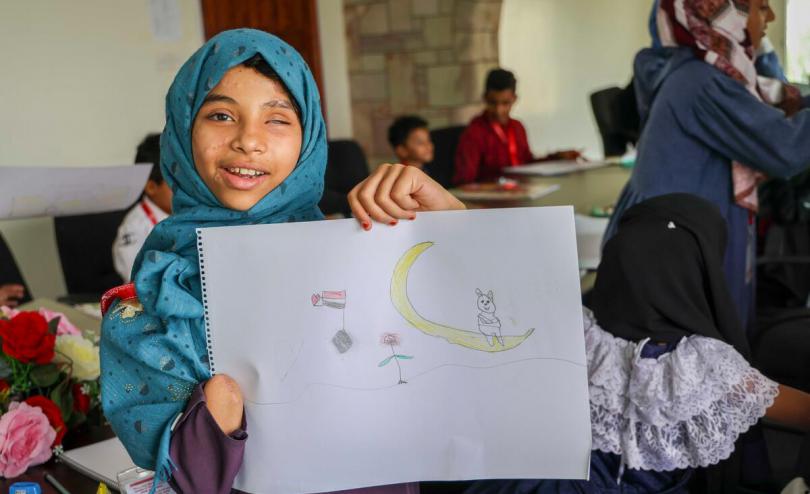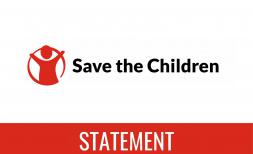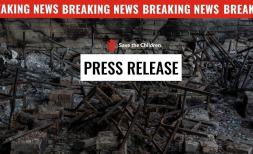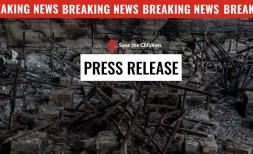World leaders must pick up bill to protect 18 million children at risk of violence, recruitment, trafficking

Maha*, 10, from Yemen, holding a drawing that she drew during a workshop for injured children organised by Save the Children (AHMED ALBASHA/Save the Children)
OSLO, 5 June 2023 – A shortfall of nearly $650 million in child protection funding is leaving nearly 18 million vulnerable children and caregivers living in the world’s worst humanitarian crises at risk of violence, exploitation and abuse, said Save the Children.
As world leaders gather for the Oslo Conference on Protecting Children in Armed Conflict, Save the Children with partners launched a report, “Unprotected: An Analysis of Funding for Child Protection in Armed Conflict”, showing that in many countries where war and violence persist funding is not keeping pace with the rising numbers of families and children at risk.
In 2022, around 22.4 million children and their caregivers in most need were targeted for child protection services requiring funding of nearly $795 million. However, governments only found the money for 19% of this, creating a funding vacuum of over $646 million, and leaving nearly 18 million boys, girls and caregivers without protection and assistance.[1]
Child protection services are critical to keep children safe from harm, particularly children living in war zones or conflict-affected countries. These services protect children from grave violations that occur during war, including recruitment and use by armed groups, child marriage, sexual violence, and killing and maiming. Money can also be used to support caregivers looking after unaccompanied children, or poverty-stricken families struggling to care for their children.
If this trend of underfunding is allowed to continue, the report predicts there will be a $1 billion shortfall for child protection in conflict zones by 2026.
This growing funding deficit comes as more and more children are living in areas of armed conflict. Save the Children’s annual estimates of children living in armed conflict calculated by the Peace Research Institute Oslo (PRIO) based on conflict data from the Uppsala Data Program (UCDP) show that in 2022 about 468 million children – more than 1 out of 6 – were living in a conflict zone. This number has almost doubled since the mid-1990s.
There has also been a jump in the number of boys and girls living on the frontline in the world’s deadliest countries. Last year, 250 million children lived within 50 kms of a conflict zone in countries where more than 1,000 people died in battle within one year – up 12% from over 220 million children two years ago.
Failure to protect the most vulnerable children in the world’s worst battle zones underpins countries’ failure to meet one of the UN’s 2030 Sustainable Development Goals (SDGs) – the promotion of peace. The SDGs were adopted in 2015 but since then the number of children living in conflict zones has spiked nearly 28%, jumping to 468 million last year.
Speaking from the Oslo Conference on Protecting Children in Armed Conflict, Save the Children International CEO Inger Ashing said:
“Weare witnessing a child protection crisis that will have implications for generations to come. We hope the Oslo Conference will be a game changer for the protection of children in armed conflict. Countries must get back on track; they must ramp up their efforts to prevent grave violations against children, help boys and girls that have survived war, and commit to lasting, sustainable peace.
“With proper funding, the impact of violence on a child’s life can be reduced. A child living in a conflict zone can’t learn effectively; they are at risk of getting separated from their family during hostilities; they are also targets for traffickers and those forcing children into child labour. Putting in place strong child protection programmes will help boys and girls living with war to learn, develop and thrive – ultimately, it will have a direct impact on our shared peace and security.”
Save the Children’s research also shows that in Europe, the number of children exposed to conflict quadrupled in just one year, from two to nine million children, fuelled by the war in Ukraine.
Africa remained the region with the highest total of children living in conflict zones – around 183 million. West and Central Africa is also the region with the highest number of children recruited by armed groups.
Junior*, 17, from the Democratic Republic of Congo, spent eight months as a child solider in an armed group in 2018. At the age of 12, he was separated from his family due to violence perpetrated by armed groups in his community:
“Friends convinced me to join an armed vigilante group to defend our community from attacks by other armed groups... I had no place to sleep and I didn’t eat well. I was in charge of looking for food for the fighters. Often, I was forced to go into the city to steal, I’d only get rest after providing sustenance for our chief.
“It was hard for me. I was a slave and experienced a life of servitude...There were three boys and one girl in our group. The girl was required to sleep with our chief every day... Twice, I went into battle against other armed groups. I couldn’t handle this violence and these atrocities. Luckily for me, I made it out alive.”
After eight months, Junior* was freed by a project run by a Save the Children partner organisation. Since then, he has benefitted from psychological support, and found a passion as a tailor.
As in previous years, the Middle East continued to have the highest share of children living in conflict zones relative to the total child population – 39% of children in the region, or one in three.
Children across 10 conflict affected countries have shared their messages and calls to actionto world leaders ahead of the Oslo Conference. One child, 10-year-old *Maha from Yemen, was injured by a landmine explosion while collecting wood with her sister:
“We finished collecting the wood and were about to return home...There was a big stump that I wanted to take with me. I pulled it, and an explosion occurred. I was unconscious. I knew nothing and wasn’t even aware of my wounded eyes.
“I wish no one else had to endure what I experienced. If I had a superpower, I would put an end to the war. I would make the city safe – the entire city – to ensure that nobody is harmed.”
Child protection remains woefully underfunded within overall humanitarian responses – but the cost is not insurmountable. The requirements for child protection represent only 2% of humanitarian requirements in countries where children are in most need.
Save the Children is calling on world leaders, donors, members of the UN, and NGOs to transform this raised awareness into collective action and work together to prioritise child protection funding in humanitarian responses —and to support children impacted by conflict, including those who are recruited.
---ENDS---
Notes:
[1] If only 19% of funding was delivered, we understand that only 1/5 of the 22.4 million children and caregivers targeted for assistance were reached. This is calculated based on the average spend on each person in need. In reality the costs vary, for example, psychosocial support activities cost between $16-83 USD per child, while assistance and reintegration of children associated with armed groups and forces costs between $300-1500 per child.
*Names have been changed to protect identity
FULL REPORTS
Unprotected: An Analysis of Funding for Child Protection in Armed Conflict:
- The main source of funding for child protection in humanitarian settings is bilateral donor governments (comprising 75% of all child protection funding). The top three donors for 2022 were the USA, Germany, and the European Commission’s Humanitarian Aid and Civil Protection Department.
- Child protection is consistently and proportionally less funded than other sectors. In recent years, overall, 60% of funding asked for, was delivered, whereas child protection was only 22% funded in 2021 and 19% funded in 2022.
- The numbers of children needing child protection are increasing, but the proportion of humanitarian response funding for child protection is not keeping pace. The number of children and caregivers in need of protection services stood at 66 million in 2022; 30% of these children and caregivers (22.4m) were targeted to receive assistance.
- By 2026, there will be a $1 billion funding gap for child protection funding in conflict settings, if the trend of underfunding is allowed to continue. With the funding requirement forecast to climb to $1.37bn by 2026, this equates to a 78% funding gap: a drastic rise from a funding gap in 2020 of $325m. In just six years, the funding gap is set to triple.
- The Analysis of Funding for Child Protection in Armed Conflict has been written by Save the Children in collaboration with the Alliance for Child Protection in Humanitarian Action, the Global Child Protection Area of Responsibility (CP AoR), and Humanitarian Funding Forecasting. It is a special edition in an annual report series titled Unprotected, first published in 2019.
- The Alliance for Child Protection in Humanitarian Action is a global, interagency group that sets standards and provides technical support to ensure that efforts to protect children from violence and exploitation are of high quality and effective.
- The Global Child Protection Area of Responsibility (Global CP AoR) is specifically focused on enhancing child protection coordination and response in humanitarian contexts. CP AoR ensures that the efforts of national and international actors to protect children are well coordinated, achieving maximum quality and impact.
- Humanitarian Funding Forecasting is an initiative that works to illuminate the hidden stories of humanitarian funding with the aim that we can make decisions based on data-driven analysis, evidence and forecasts.
Children Affected by Armed Conflict report:
- In 2022, approximately 468 million children (18.8%, or more than 1 out of 6) were living in a conflict zone. This constitutes a 2.8% increase from 2021, when 455 million children lived in a conflict zone.
- In 2022, approximately 1.7 billion children (68%, or more than two out of three children) were living in a country affected by conflict.
- In 2022, approximately 250 million locally conflict-exposed children were living in high intensity conflict countries, i.e. conflicts with more than 1,000 battle-related deaths. This is an increase of 6.3% from 2021 when approximately 235 million conflict-exposed children lived in high intensity conflict countries, and a 12% increase since 2020 when the corresponding number was some 223 million children.
- The share of children living in conflict zones has almost doubled, from some 10% in the mid-1990s to almost 19% in 2022.
- In 2015, when the SDGs were developed, 366 million lived in conflict zones – in 2022 it is 468 million– a jump of 28% in less than a decade.
Children’s Call to action, ‘We don’t have magic powers, but you do’:
- Children from nine different conflict affected countries share their messages and calls to action with world leaders ahead of the Oslo Conference.
Save the Children is a global child rights organisation working for and with children so they can survive, learn and be protected. Save the Children runs programmes that directly reach around 50 million children in around 120 countries every year.
**************************************************************************************************************
Media out of hours (BST/GMT): media@savethechildren.org.uk




